The Best Soft Scrambled Eggs Recipe: Easy, Buttery, and Fluffy Every Time
Soft scrambled eggs are a culinary delight, renowned for their incredibly tender, creamy, and buttery texture. Far from the dry, rubbery eggs many of us grew up with, perfectly soft scrambled eggs are a testament to simple ingredients and a precise technique. They’re not just a delicious breakfast staple; they’re a versatile dish that can be enjoyed at any time of day, offering a fantastic blend of nutrition and ease. In this comprehensive guide, we’ll dive deep into mastering the art of soft scrambled eggs, revealing the secrets to achieving that coveted restaurant-quality fluffiness in under 5 minutes. Get ready to elevate your egg game and transform your breakfast routine!
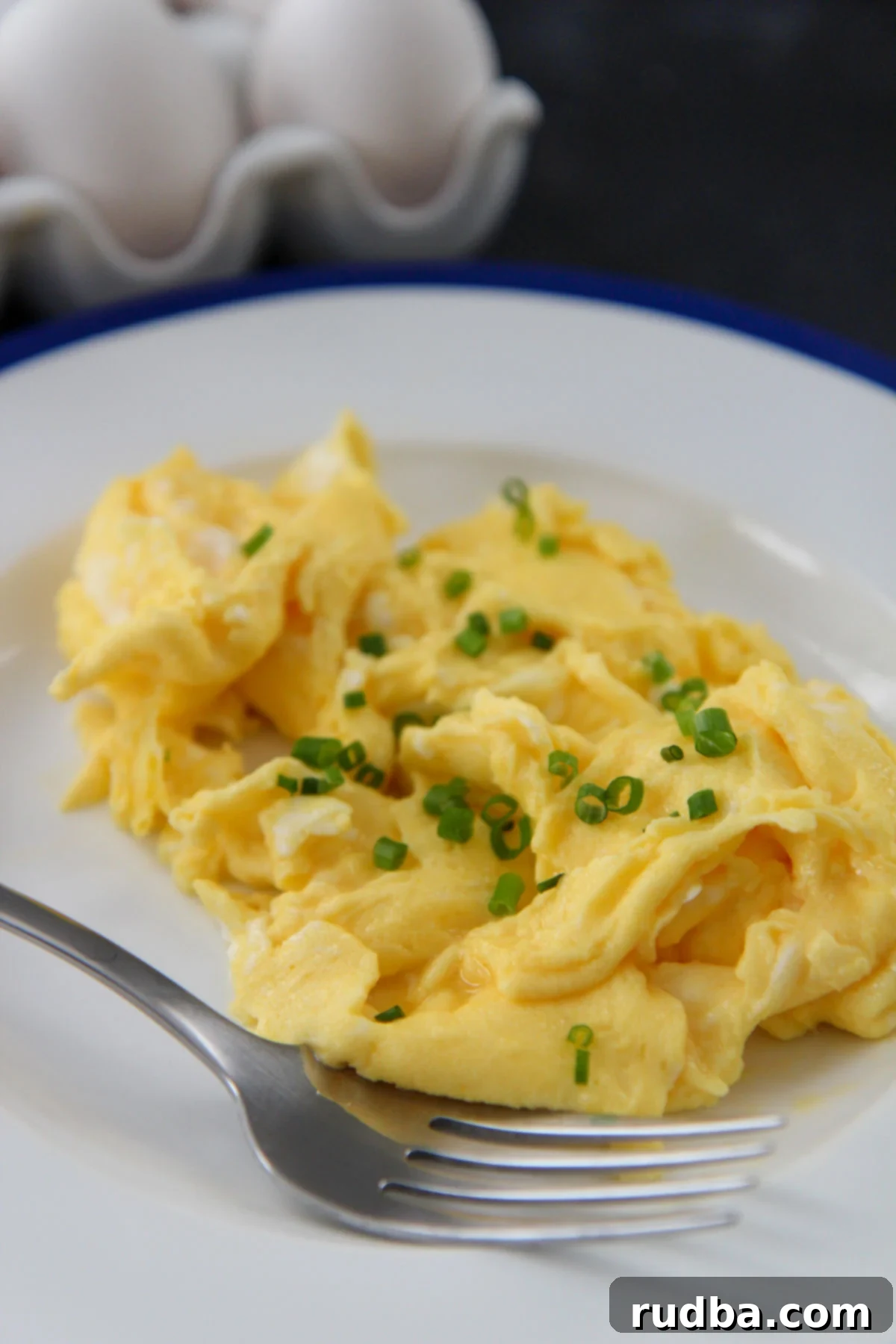
Why Soft Scrambled Eggs Are Your New Go-To Meal
Whether you’re looking for a quick morning bite, a light lunch, or a protein-packed dinner, soft scrambled eggs fit the bill perfectly. They are incredibly versatile and adaptable to countless flavor profiles. Beyond their exquisite taste and luxurious texture, eggs are a nutritional powerhouse, making them an ideal choice for a healthy lifestyle. Each average egg contains approximately 6 grams of high-quality protein, essential for muscle repair, energy, and overall body function. They are also naturally low in carbohydrates and inherently keto-friendly, making them an excellent option for those following specific dietary regimens.
Furthermore, eggs are packed with vital vitamins and minerals, including Vitamin D, B vitamins, selenium, and choline, which supports brain health. Their affordability and widespread availability also make them a practical choice for meal planning. With a few simple ingredients and minimal effort, you can create a truly satisfying and wholesome meal that delights the palate and nourishes the body.
The Secret to Unbeatably Fluffy Scrambled Eggs: Water and Butter
Many traditional scrambled egg recipes call for milk or cream to achieve a creamy texture. However, for genuinely soft and fluffy results, a splash of water is often the superior choice. Unlike milk, which can weigh down the eggs and make them a bit denser, water creates steam as it heats, resulting in lighter, airier curds. This simple trick helps to achieve that delicate, melt-in-your-mouth consistency that defines perfect soft scrambled eggs.
Beyond water, the quality and amount of butter play a crucial role. Generous use of real butter not only adds an incredible richness and flavor but also ensures the eggs cook evenly without sticking to the pan. Butter also contributes to the beautiful golden hue and silky finish of the eggs. The technique is equally important: gentle, occasional stirring with a silicone spatula prevents the eggs from setting too quickly and allows for larger, softer curds to form. Knowing precisely when to remove them from the heat – while they are still slightly wet and glossy – is the ultimate key to avoiding overcooked, dry eggs. It’s a quick process, often taking less than two minutes from pan to plate!
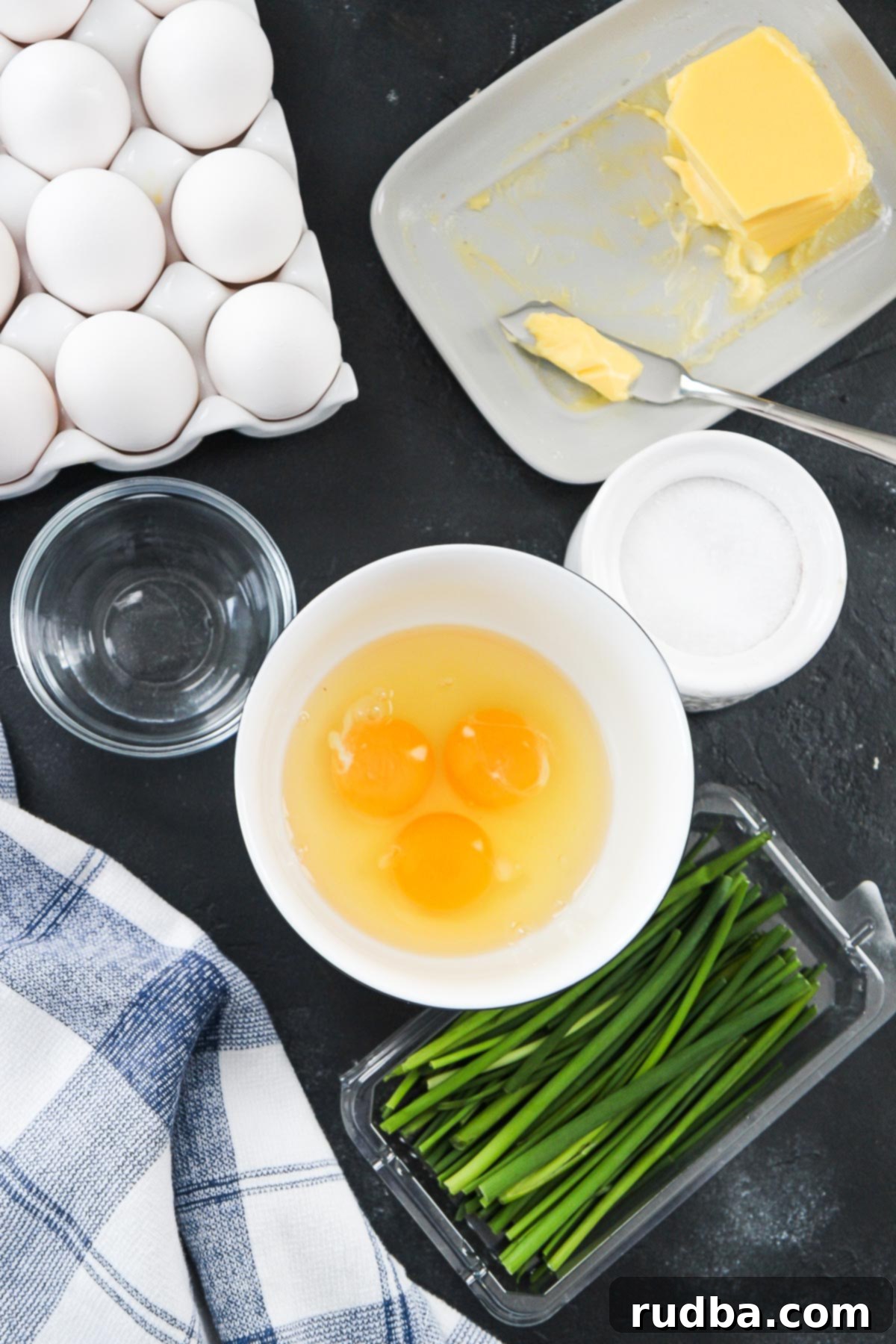
Essential Ingredients You’ll Need for Perfect Soft Scrambled Eggs:
Achieving culinary perfection often hinges on the quality of your ingredients. For soft scrambled eggs, a few fresh, high-quality items are all it takes to make a remarkable difference.
- Fresh Eggs: The foundation of this dish. Opt for the freshest eggs you can find, preferably free-range or organic, as they often have richer yolks and better flavor.
- Water: Just a tablespoon per three eggs helps create steam, leading to incredibly light and fluffy scrambled eggs.
- Quality Butter: Unsalted butter is preferred, allowing you to control the saltiness. It provides richness, prevents sticking, and helps achieve that signature creamy texture.
- Salt and Freshly Ground Black Pepper: Kosher salt or sea salt enhances the natural flavor of the eggs. Pepper adds a touch of warmth and aroma. It’s best to season after cooking to prevent the salt from breaking down the egg proteins prematurely.
- Fresh Chives (optional, but highly recommended): A sprinkle of finely chopped fresh chives adds a delicate oniony flavor and a pop of vibrant green color, elevating the dish’s freshness and presentation.
Top Tips for Unbeatable Soft Scrambled Eggs:
Transforming ordinary eggs into an extraordinary meal is easier than you think with these expert tips:
- Season Smartly: Always season your scrambled eggs with salt and pepper *after* they are cooked and served on a plate. Adding salt too early can break down the egg proteins, making them watery or slightly tougher.
- Whisk Vigorously: Don’t just lightly stir your eggs. Whisk them vigorously with the water until they are uniform in color and slightly frothy, indicating plenty of air has been incorporated. This is crucial for fluffiness.
- Choose the Right Pan: A small, non-stick skillet is your best friend. This ensures the eggs don’t stick and allows for easy manipulation of the curds.
- Master the Heat: Cook over medium-high heat. The goal is quick cooking without browning. Too low, and they’ll dry out; too high, and they’ll cook too fast and unevenly.
- Gentle and Consistent Stirring: Use a silicone spatula and stir occasionally, rather than constantly. Gently scrape the bottom and sides of the pan, folding the cooked portions into the uncooked. This creates those larger, soft curds.
- Don’t Overcook: This is the most critical tip. Remove the eggs from the heat when they are still visibly moist and slightly undercooked. They will continue to cook from residual heat in the pan. They should be custardy and glossy, not dry.
- Serve Immediately: Soft scrambled eggs are best enjoyed fresh off the stove. Their delicate texture diminishes as they cool.
Hard vs. Soft Scrambled Eggs: Understanding the Difference
While both are popular ways to enjoy eggs, there’s a significant difference in texture and cooking method between hard and soft scrambled eggs. Understanding this distinction is key to achieving your desired outcome.
- Hard Scrambled Eggs: These are cooked for a longer period until all the liquid has evaporated, and the eggs are firm and thoroughly set. They tend to have smaller, denser curds and a drier, more crumbly texture. While still delicious, they lack the creamy richness of their softer counterparts. They are often cooked over higher heat with more vigorous stirring.
- Soft Scrambled Eggs: The star of our show, soft scrambled eggs are cooked very quickly over medium-high heat and removed from the pan while still slightly moist and custardy. The curds are larger, tender, and incredibly creamy, almost like a delicate custard. This method preserves the eggs’ natural moisture and creates a luxurious, buttery mouthfeel. The goal is to cook them just enough so they are set but still have a beautiful, glistening sheen.
How to Make Soft Scrambled Eggs – Step by Step
Making truly perfect soft scrambled eggs is a simple, quick process that yields incredible results. Follow these detailed steps to achieve buttery, fluffy perfection every time:
- Prepare Your Eggs: In a medium bowl, crack 3 large fresh eggs. Add 1 tablespoon of water. Using a fork or a small whisk, whisk the eggs vigorously for about 30 seconds to 1 minute, until the yolks and whites are fully combined, and the mixture is slightly frothy with small bubbles. This incorporates air, which contributes to the fluffiness.
- Heat the Skillet: Place a small (8-inch) nonstick skillet over medium-high heat. Allow it to heat for about 30 seconds. Add 1 tablespoon of butter to the hot skillet. Swirl the butter around until it melts and coats the entire bottom surface of the pan. The butter should be bubbling gently, but not browning.
- Pour and Stir: Pour the whisked egg mixture into the hot, buttered skillet. Let the eggs sit undisturbed for about 10-15 seconds, allowing the edges to just begin to set.
- Cook and Fold: Using a silicone spatula, gently push the cooked egg from the edges towards the center of the pan. Tilt the pan to allow the uncooked egg to flow into the empty spaces. Continue this gentle folding motion, occasionally stirring and scrambling, for about 1 minute. The goal is to create large, soft curds.
- Remove and Finish: As soon as the eggs are mostly set but still look moist and slightly glossy (a tiny bit wet is perfect, as they will continue to cook off the heat), remove the skillet from the burner. Season immediately with salt and freshly ground black pepper to taste. If using, sprinkle with 1 teaspoon of fresh chives. Gently stir to combine.
- Serve and Enjoy: Transfer the soft scrambled eggs to a plate immediately. Serve them hot with your favorite accompaniments. The entire cooking process, from adding eggs to the pan until they’re ready to serve, should take no more than 1-2 minutes.
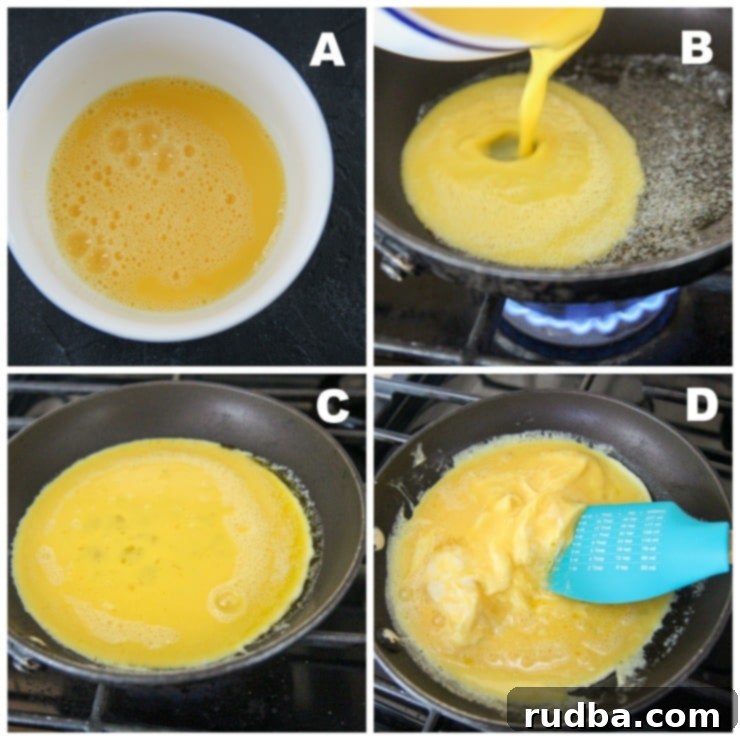
Why This Soft Scrambled Eggs Recipe is a Game-Changer
You might wonder why a recipe for something as seemingly simple as scrambled eggs needs an entire guide. The truth is, while eggs are easy to cook, making *truly delicious* soft scrambled eggs is a nuanced art. This recipe is a game-changer because it focuses on minimum ingredients for maximum impact. By utilizing fresh eggs, real butter, a splash of water, and the perfect timing, we unlock incredible flavor and texture. You’ll likely find these four essential ingredients always on hand, making this a convenient and reliable recipe whenever hunger strikes. Forget complicated techniques; this method guarantees a buttery, creamy, and satisfying result every single time. It’s an accessible luxury that elevates your everyday meals.
Elevate Your Scrambled Eggs: Delicious Add-ins
While soft scrambled eggs are magnificent on their own, they also serve as a perfect canvas for additional flavors. Experiment with these fantastic add-ins to customize your dish:
- Crispy Bacon or Diced Ham: Cooked and crumbled bacon bits or small pieces of sautéed ham add a smoky, savory depth and satisfying texture.
- Sautéed Vegetables: Finely diced peppers (bell peppers, jalapeños for a kick), onions (caramelized or fresh), mushrooms, or a handful of fresh spinach can be cooked down before adding the eggs for extra nutrients and flavor.
- Cheese: A sprinkle of your favorite cheese just as the eggs are finishing can create a gooey, melty delight. Cheddar, Gruyère, feta, goat cheese, or a sharp Parmesan are all excellent choices.
- Fresh Herbs: Beyond chives, consider adding finely chopped dill, parsley, tarragon, or even a touch of basil for different aromatic profiles.
- Spice and Heat: A dash of your favorite hot sauce, a pinch of red pepper flakes, or a spoonful of salsa can instantly liven up your plate.
- Avocado: Sliced or mashed avocado served alongside adds healthy fats and a creamy texture that complements the eggs beautifully.
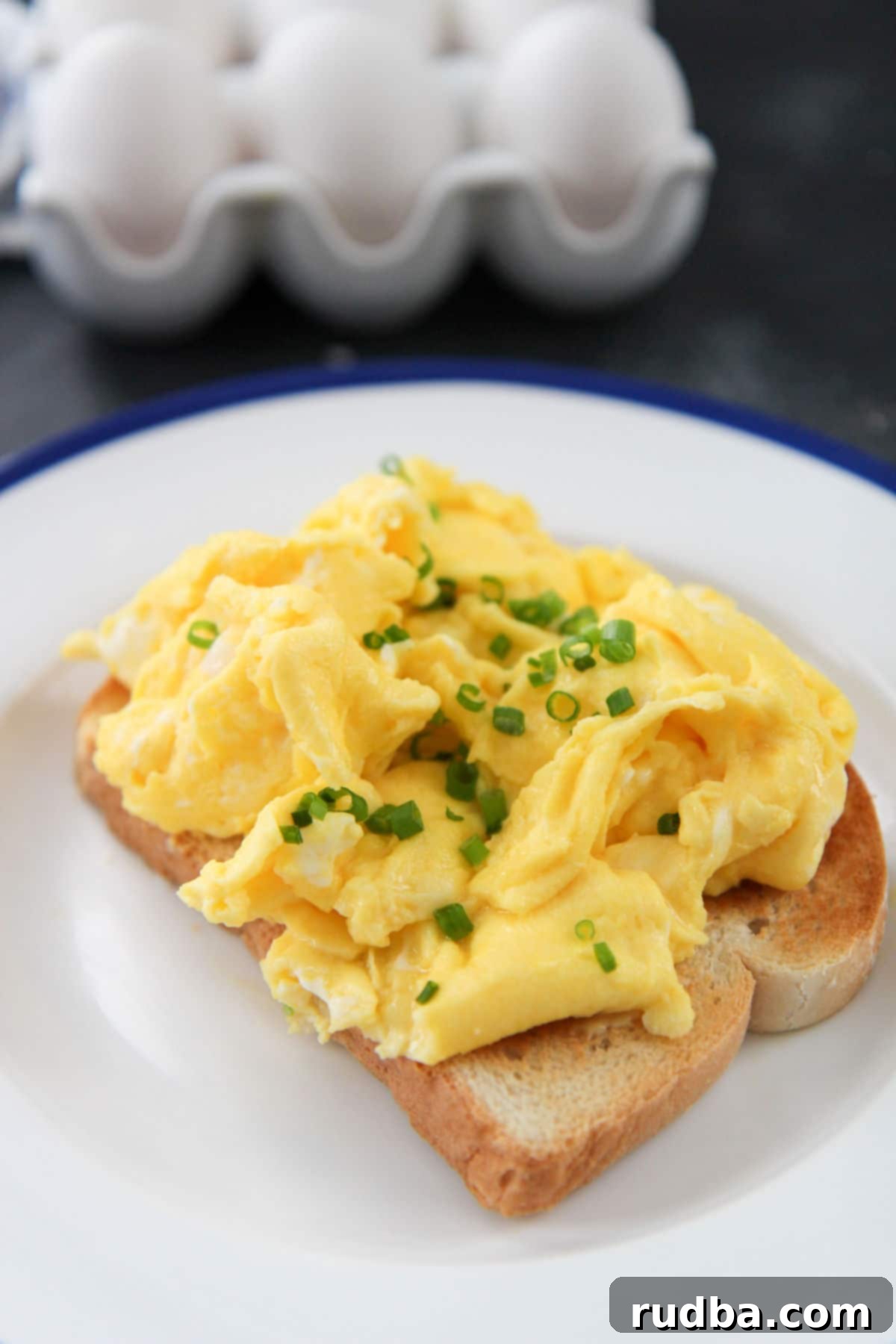
Serving Suggestions: What to Pair with Your Soft Scrambled Eggs
Once you’ve mastered the art of soft scrambled eggs, the possibilities for serving them are endless. Here are some popular and delicious pairings:
- Classic Toast: Simple buttered toast, sourdough, or whole wheat bread is a timeless companion, perfect for soaking up any buttery goodness.
- Fluffy Croissants: For a touch of French elegance, serve your eggs with a warm, flaky croissant.
- Fresh Fruit: A side of vibrant fresh berries, sliced avocado, or citrus segments provides a refreshing contrast to the richness of the eggs.
- Hash Browns or Roasted Potatoes: A hearty side of crispy potatoes makes for a more substantial meal.
- Sautéed Greens: A quick sauté of spinach, kale, or asparagus can add a healthy and delicious green element.
- On a Sandwich or Wrap: Pile your soft scrambled eggs onto a breakfast sandwich with cheese and bacon, or tuck them into a warm tortilla with salsa.
- As Part of a Bigger Breakfast Platter: Combine them with sausages, bacon, pancakes, or waffles for a full breakfast spread.
Frequently Asked Questions (FAQ) about Soft Scrambled Eggs
Q: Can I use milk or cream instead of water?
A: While milk or cream is commonly used in scrambled eggs, for truly *soft and fluffy* results, water is generally preferred. Milk/cream can make eggs heavier and denser, whereas water creates steam that helps the eggs puff up and become lighter. If you prefer a richer, denser texture, you can use a splash of milk or cream, but be aware it will change the final consistency.
Q: What kind of pan is best for scrambled eggs?
A: A good quality non-stick skillet (preferably 8-10 inches for 2-4 eggs) is highly recommended. It prevents sticking, ensures even cooking, and allows for easy scraping and folding of the eggs, which is crucial for soft curds.
Q: How many eggs should I make per person?
A: Generally, 2-3 large eggs per person is a good serving size for breakfast or a light meal. Adjust based on appetite and what other dishes you are serving.
Q: How can I prevent my scrambled eggs from becoming rubbery?
A: The key to avoiding rubbery eggs is not to overcook them. Remove them from the heat when they are still slightly wet and glistening. Use medium-high heat for quick cooking, whisk vigorously before cooking to incorporate air, and use a good amount of butter to prevent sticking and add moisture.
Q: Can I prepare the egg mixture in advance?
A: It’s best to whisk your eggs just before cooking. While you can crack them into a bowl a little ahead of time, whisking them too far in advance can cause the proteins to break down, potentially affecting the final texture. Freshly whisked is always best for optimal fluffiness.
Q: What’s the best way to clean the pan after making scrambled eggs?
A: Since you’re using a non-stick pan and ideally not overcooking, clean-up should be easy. Allow the pan to cool slightly, then wash it with warm, soapy water and a soft sponge. Avoid abrasive scrubbers to preserve the non-stick coating.
Mastering soft scrambled eggs is a culinary skill that will serve you well for years to come. With just a few simple steps and the right technique, you can enjoy a perfect, restaurant-quality breakfast (or any meal!) in your own kitchen. Experiment with different add-ins and serving suggestions to make this versatile dish truly your own. Happy cooking!
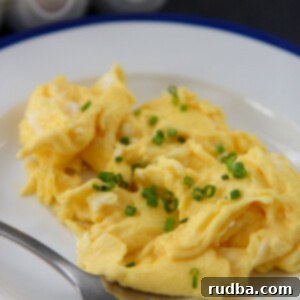
Soft Scrambled Eggs
Save RecipeSaved Recipe
Pin Recipe
Rate Recipe
Print Recipe
Ingredients
- 3 eggs
- 1 tbsp water
- 1 tbsp butter
- salt and pepper to taste
- 1 tsp fresh chives
Instructions
-
Place a small nonstick skillet on the stove, and turn up the heat to medium-high.
-
Add the butter and coat the entire skillet with it.
-
Crack the eggs in a bowl and add the water. Whisk it until its smooth with lots of bubbles.
-
Pour the eggs in the skillet and stir constantly using a rubber spatula.
-
Cook for one minute. Season with salt and pepper and garnish with fresh chives if desired.
Notes
- Season the eggs when they’re completely cooked.
- Whisk the eggs with water for about a minute.
- Stir the eggs constantly with a rubber spatula while cooking.
Nutrition
Nutrition information is automatically calculated, so should only be used as an approximation.
Additional Info
Like this recipe? Leave a comment below!
More Delicious Breakfast Recipes You’ll Love:
If you enjoyed mastering the art of soft scrambled eggs, you’ll surely love exploring these other fantastic breakfast and brunch recipes that are just as easy to make and equally delicious. Expand your morning menu with these tried-and-true favorites:
-
Banana Pancakes:
Fluffy, sweet, and bursting with banana flavor, these pancakes are a comforting way to start any day. Perfect for a weekend treat!
-
Scrambled Eggs with Peppers and Onions:
If you’re looking to add a colorful and savory twist to your scrambled eggs, this recipe features vibrant bell peppers and sweet onions, creating a hearty and flavorful meal.
-
Lemon Ricotta Pancakes:
Experience an elevated pancake experience with these incredibly light, fluffy, and subtly tangy lemon ricotta pancakes. They’re a gourmet touch to your breakfast table.
-
French Toast Recipe:
Classic, comforting, and always a crowd-pleaser. This French toast recipe delivers golden, custardy slices of bread, perfect for a special breakfast or brunch.
Happy cooking, and enjoy your delightful breakfast creations!
